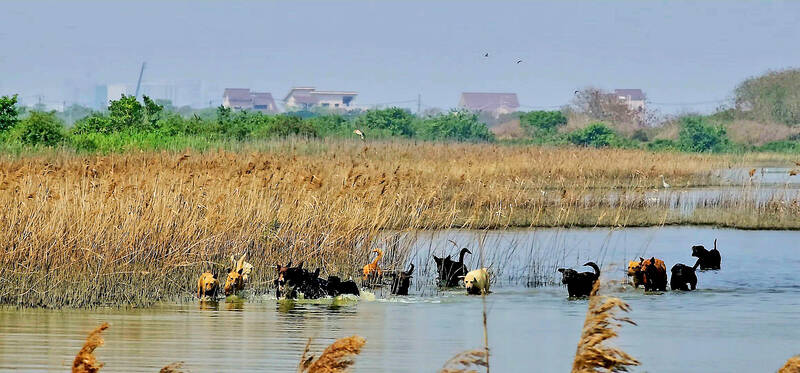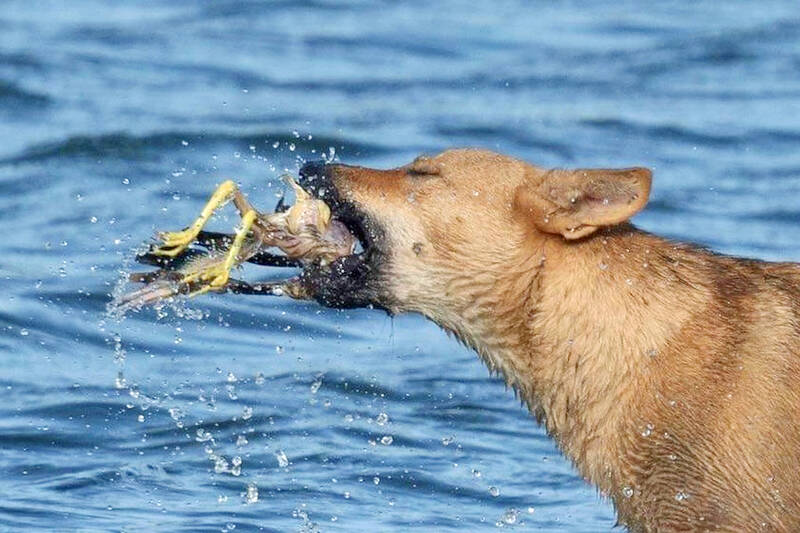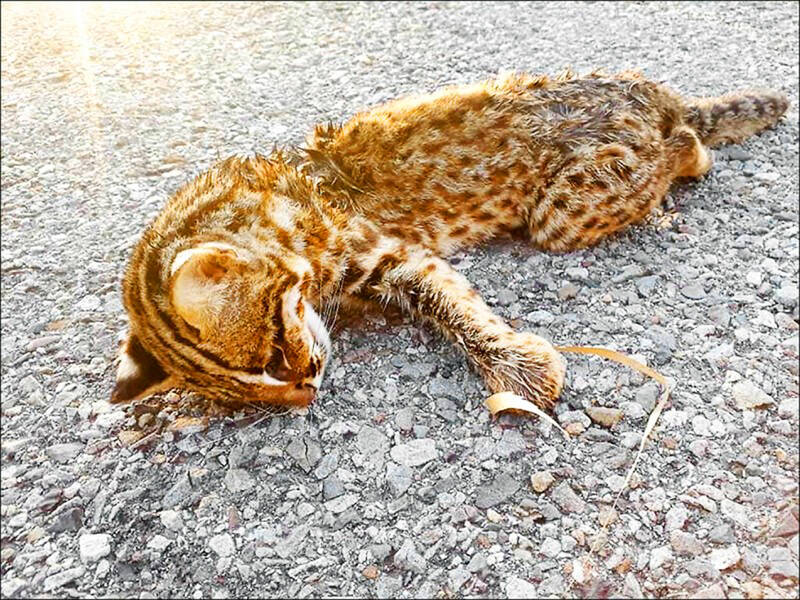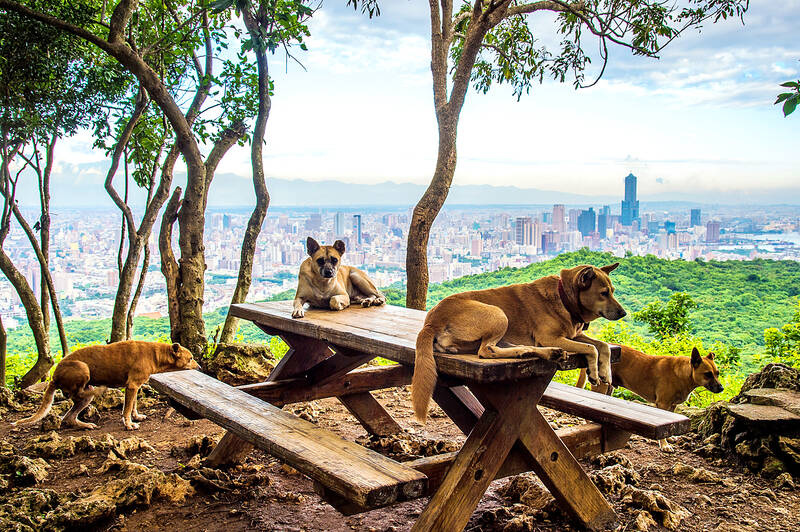Throughout the world, free-roaming dogs and cats are a major threat to wildlife.
It’s hard to say which of these two carnivores is worse. According to an estimate published in 2013, free-ranging cats kill between 1.3 billion and 4 billion birds and 6.3 billion and 22.3 billion mammals (mainly rodents and shrews), each year in the US alone. Unowned cats, rather than pets, cause most of these deaths. A 2017 paper on the global impact of domestic dogs says they have “contributed to 11 vertebrate extinctions and are a known or potential threat to at least 188 threatened species worldwide.”
DOG-ON-BIRD VIOLENCE

Photo: Chen Wen-chi, Taipei Times
Dog attacks on wildlife are a common occurrence in Taiwan. Last year, then minister of agriculture Chen Chi-chung (陳吉仲) said the number of free-roaming dogs around the country could be 180,000. Some of them were abandoned by their human owners, but many were born to stray mothers.
On March 17, Liberty Times (the Chinese-language sister newspaper of Taipei Times) reported that up to 20 stray dogs were hunting egrets in Cieding Wetland (茄萣濕地) in the northwestern corner of Kaohsiung.
Last September, the Central News Agency published horrifying images of dog-on-bird violence provided by the Wild Bird Society of Hsinchu. The accompanying report explained that the siltation of Jincheng Lake (金城湖), a spot popular with birdwatchers, had made it possible for stray dogs to enter parts of Siangshan Wetland (香山濕地), where they attacked resident and migratory water birds eating eggs and chicks.

Photo Hsinchu City Wild Bird Society
The city governments of both Kaohsiung and Hsinchu promised to step up efforts to trap and remove feral dogs.
The number of dog-attack victims treated by the WildOne Wildlife Rescue Center in Taitung County’s Chihshang Township (池上) has grown steadily, from 5 in 2020 to 84 last year. However, the NGO’s staff point out that this increased caseload may not mean dog attacks are more frequent than before. They say their inspection processes have become more careful, and it’s possible that more people than before are reporting injured wild creatures to the authorities.
WildOne’s front-line experience suggests that Reeves’s muntjacs and Formosan pangolins are among the animals most frequently harmed by dogs, while all kinds of small and medium-sized birds are vulnerable to feline hunters. Whatever the reasons, the issue of stray animals still needs to be taken seriously, say WildOne's staff.

Photo: Miaoli Big and Small, Facebook
A report in Liberty Times last June quoted the head of the Ministry of Agriculture’s Taiwan Biodiversity Research Institute (TBRI) as saying that, of the 50 pangolins sent to TBRI for emergency care over the previous three years, half had suffered dog bites, almost always to their tails. Pangolins use their semi-prehensile tails to climb and find food, while infant pangolins ride on their mothers’ tails. Serious tail injuries thus jeopardize not only an adult pangolin’s chances of survival, but also its ability to raise its young.
The TBRI chief also said that dogs were believed to be responsible for the deaths of 7 of the 14 leopard cats the institute had been tracking since 2017. Estimates of Taiwan’s leopard cat population range from 400 to 600, so this is a significant loss.
THREAT TO NATIONAL PARKS

Photo: Chang Chung-i, Taipei Times
The situation is especially acute in Shoushan National Nature Park (壽山國家自然公園) adjacent to central Kaohsiung, and in Yangmingshan National Park (陽明山國家公園), which is surrounded by the cities of Taipei and New Taipei (combined population: 6.54 million).
During a May 10 meeting of the Legislative Yuan’s Economics Committee last year, Democratic Progressive Party lawmaker Chiu Chih-wei (邱志偉) cited a 2021-2022 survey which indicated that the number of Reeves’s muntjacs in the Shoushan area had declined by more than 90 percent over a period of 10 years, with dogs being the main reason for this precipitous drop. With the muntjac population having fallen to a mere 50 to 63 individuals, there is a real risk of local extinction.
A December 2018 report published by Shoushan National Nature Park headquarters makes it clear just how quickly packs of dogs can establish themselves. Intensive anti-dog operations have an immediate impact, it stated, but if there’s a let up of just two months, the canine population resumes its upward trajectory. The report also noted that many of the park’s dogs are found at spots visited by a lot of tourists, or where people feed the strays.
Some believe that, if they give food to unowned dogs, the canines won’t eat wild creatures. There’s no evidence for this. In fact, it may have the opposite effect.
According to a paper by Taiwanese researchers published in Scientific Reports in June 2019, “dogs form packs and can reach a very high density due to food subsidies from humans. Pack hunting may lead to high predation success, and subsidized food resources may break down predator-prey regulation, increasing the chance for the predators to exceed their carrying capacity” and destabilize the ecosystem.
Even if they don’t prey on native animals, invasive species like dogs and cats may compete for food and transmit diseases to other mammals.
The authors of the 2019 paper focused on Yangmingshan, noting that, while the national park was established to conserve lowland ecosystems, this “has become increasingly challenging due to its close proximity to the metropolis.” In addition to the 12,000 people who live within the park and the millions of humans who visit each year, “the park has approximately 1,000 free-roaming dogs and at least 400 free-roaming cats.”
Site-use data for dogs, cats, and nine species of native mammals collected and analyzed by the researchers suggests that free-roaming dogs have a greater impact on species variety and the number of native mammals than nearby human settlements.
NO-KILL POLICY
Yen Shih-ching (顏士清), one of the authors of the 2019 paper and an assistant professor in National Tsing Hua University’s Center for General Education and Department of Life Science, says: “In recent years, the number of free-roaming dogs has been increasing annually, and incidents of wild animals being attacked by dogs have also been rapidly rising. This is likely related to the hasty implementation of the no-kill policy in 2017, which needs additional support measures.”
Since early 2017, public animal shelters have barred euthanizing animals in their care. As a consequence, Yen explains, TNR (trap-neuter-return) has become the authorities’ main tool for controlling the number of free-roaming cats and dogs.
Not only has this failed to reduce dogs-versus-wildlife conflict, but the canines which are released after neutering seldom enjoy long and happy lives. A 2019 paper for Preventive Veterinary Medicine, also co-authored by Yen, says that the apparent survival rate for free-roaming dogs in YMSNP from 2016 to 2017 was just 16.7 percent; from 2017 to 2018 it was 23.9 percent; and the two-year survival rate from 2016 to 2018 was a mere 11.5 percent. Not all strays are neutered, but Yen and his colleagues didn’t include pups in their study, “because pups usually have a very low survival rate and are easily captured by rangers.”
Yen says that TNR shouldn’t be the primary strategy, and that managing the problem requires a multifaceted approach. “Genuine compassion lies in ensuring all dogs have owners who fulfill their complete responsibilities for care,” he says.
As reported in this newspaper on Sept. 26 (“Targeted stray dog relocations to begin”), the authorities have begun moving free-roaming canines away from sensitive habitats. Given the widespread opposition to euthanizing trapped dogs, this is perhaps the only way forward. However, Taiwan’s animal shelters are already overcrowded — and some nature lovers express frustration at the glacial pace of official efforts to solve the problem.
Responding to a May 11, 2022 post on Yangmingshan National Park’s Facebook page that described the use of GPS collars to track strays within the park, one person commented: “People aren’t allowed to pick up fallen leaves, but stray dogs and cats are allowed to TNR? What’s the use of budgeting for national park conservation?”
Even if the “gradual reduction” in dog numbers the authorities predict is achieved, “How many wild animals will die in the meantime?” asked another.
One thing’s for sure: “No kill” doesn’t mean an end to tragic animal deaths. The current approach falls between two stools: It allows free-roaming dogs to harass and kill wildlife, without saving many of those canines from short, miserable lives.
Steven Crook, the author or co-author of four books about Taiwan, has been following environmental issues since he arrived in the country in 1991. He drives a hybrid and carries his own chopsticks. The views expressed here are his own.

Most heroes are remembered for the battles they fought. Taiwan’s Black Bat Squadron is remembered for flying into Chinese airspace 838 times between 1953 and 1967, and for the 148 men whose sacrifice bought the intelligence that kept Taiwan secure. Two-thirds of the squadron died carrying out missions most people wouldn’t learn about for another 40 years. The squadron lost 15 aircraft and 148 crew members over those 14 years, making it the deadliest unit in Taiwan’s military history by casualty rate. They flew at night, often at low altitudes, straight into some of the most heavily defended airspace in Asia.

Taiwan’s democracy is at risk. Be very alarmed. This is not a drill. The current constitutional crisis progressed slowly, then suddenly. Political tensions, partisan hostility and emotions are all running high right when cool heads and calm negotiation are most needed. Oxford defines brinkmanship as: “The art or practice of pursuing a dangerous policy to the limits of safety before stopping, especially in politics.” It says the term comes from a quote from a 1956 Cold War interview with then-American Secretary of State John Foster Dulles, when he said: ‘The ability to get to the verge without getting into the war is

Beijing’s ironic, abusive tantrums aimed at Japan since Japanese Prime Minister Sanae Takaichi publicly stated that a Taiwan contingency would be an existential crisis for Japan, have revealed for all the world to see that the People’s Republic of China (PRC) lusts after Okinawa. We all owe Takaichi a debt of thanks for getting the PRC to make that public. The PRC and its netizens, taking their cue from the Chinese Communist Party (CCP), are presenting Okinawa by mirroring the claims about Taiwan. Official PRC propaganda organs began to wax lyrical about Okinawa’s “unsettled status” beginning last month. A Global

Like much in the world today, theater has experienced major disruptions over the six years since COVID-19. The pandemic, the war in Ukraine and social media have created a new normal of geopolitical and information uncertainty, and the performing arts are not immune to these effects. “Ten years ago people wanted to come to the theater to engage with important issues, but now the Internet allows them to engage with those issues powerfully and immediately,” said Faith Tan, programming director of the Esplanade in Singapore, speaking last week in Japan. “One reaction to unpredictability has been a renewed emphasis on